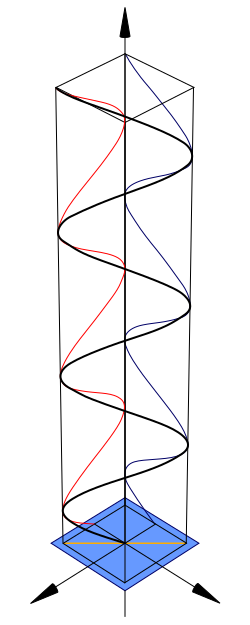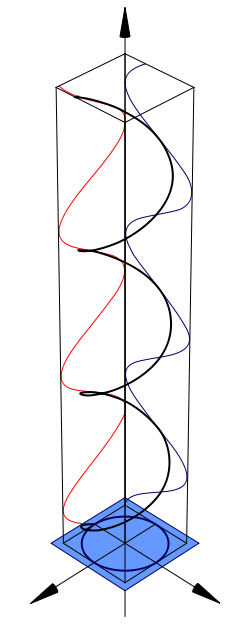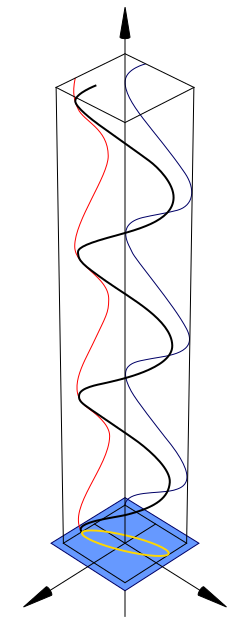Optics

| Part of a series on |
| Physics |
|---|
 |
Opticsis the branch ofphysicsthat studies the behaviour and properties oflight,including its interactions withmatterand the construction ofinstrumentsthat use ordetectit.[1]Optics usually describes the behaviour ofvisible,ultraviolet,andinfraredlight. Light is a type ofelectromagnetic radiation,and other forms of electromagnetic radiation such asX-rays,microwaves,andradio wavesexhibit similar properties.[1]
Most optical phenomena can be accounted for by using theclassical electromagneticdescription of light, however complete electromagnetic descriptions of light are often difficult to apply in practice. Practical optics is usually done using simplified models. The most common of these,geometric optics,treats light as a collection ofraysthat travel in straight lines and bend when they pass through or reflect from surfaces.Physical opticsis a more comprehensive model of light, which includeswaveeffects such asdiffractionandinterferencethat cannot be accounted for in geometric optics. Historically, the ray-based model of light was developed first, followed by the wave model of light. Progress in electromagnetic theory in the 19th century led to the discovery that light waves were in fact electromagnetic radiation.
Some phenomena depend on light having bothwave-like and particle-like properties.Explanation of these effects requiresquantum mechanics.When considering light's particle-like properties, the light is modelled as a collection of particles called "photons".Quantum opticsdeals with the application of quantum mechanics to optical systems.
Optical science is relevant to and studied in many related disciplines includingastronomy,variousengineeringfields,photography,andmedicine(particularlyophthalmologyandoptometry,in which it is called physiological optics). Practical applications of optics are found in a variety of technologies and everyday objects, includingmirrors,lenses,telescopes,microscopes,lasers,andfibre optics.
History
[edit]
Optics began with the development of lenses by theancient EgyptiansandMesopotamians.The earliest known lenses, made from polishedcrystal,oftenquartz,date from as early as 2000 BC fromCrete(Archaeological Museum of Heraclion, Greece). Lenses fromRhodesdate around 700 BC, as doAssyrianlenses such as theNimrud lens.[2]Theancient RomansandGreeksfilled glass spheres with water to make lenses. These practical developments were followed by the development of theories of light and vision by ancientGreekandIndianphilosophers, and the development ofgeometrical opticsin theGreco-Roman world.The wordopticscomes from theancient Greekwordὀπτική,optikē'appearance, look'.[3]
Greek philosophy on optics broke down into two opposing theories on how vision worked, theintromission theoryand theemission theory.[4]The intromission approach saw vision as coming from objects casting off copies of themselves (called eidola) that were captured by the eye. With many propagators includingDemocritus,Epicurus,Aristotleand their followers, this theory seems to have some contact with modern theories of what vision really is, but it remained only speculation lacking any experimental foundation.
Platofirst articulated theemission theory,the idea thatvisual perceptionis accomplished by rays emitted by the eyes. He also commented on theparityreversal of mirrors inTimaeus.[5]Some hundred years later,Euclid(4th–3rd century BC) wrote a treatise entitledOpticswhere he linked vision togeometry,creatinggeometrical optics.[6]He based his work on Plato's emission theory wherein he described the mathematical rules ofperspectiveand described the effects ofrefractionqualitatively, although he questioned that a beam of light from the eye could instantaneously light up the stars every time someone blinked.[7]Euclid stated the principle of shortest trajectory of light, and considered multiple reflections on flat and spherical mirrors. Ptolemy,in his treatiseOptics,held an extramission-intromission theory of vision: the rays (or flux) from the eye formed a cone, the vertex being within the eye, and the base defining the visual field. The rays were sensitive, and conveyed information back to the observer's intellect about the distance and orientation of surfaces. He summarized much of Euclid and went on to describe a way to measure theangle of refraction,though he failed to notice the empirical relationship between it and the angle of incidence.[8]Plutarch(1st–2nd century AD) described multiple reflections on spherical mirrors and discussed the creation of magnified and reduced images, both real and imaginary, including the case ofchiralityof the images.
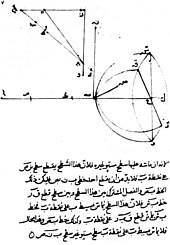
During theMiddle Ages,Greek ideas about optics were resurrected and extended by writers in theMuslim world.One of the earliest of these wasAl-Kindi(c. 801–873) who wrote on the merits of Aristotelian and Euclidean ideas of optics, favouring the emission theory since it could better quantify optical phenomena.[9]In 984, thePersianmathematicianIbn Sahlwrote the treatise "On burning mirrors and lenses", correctly describing a law of refraction equivalent to Snell's law.[10]He used this law to compute optimum shapes for lenses andcurved mirrors.In the early 11th century, Alhazen (Ibn al-Haytham) wrote theBook of Optics(Kitab al-manazir) in which he explored reflection and refraction and proposed a new system for explaining vision and light based on observation and experiment.[11]He rejected the "emission theory" of Ptolemaic optics with its rays being emitted by the eye, and instead put forward the idea that light reflected in all directions in straight lines from all points of the objects being viewed and then entered the eye, although he was unable to correctly explain how the eye captured the rays.[12]Alhazen's work was largely ignored in the Arabic world but it was anonymously translated into Latin around 1200 A.D. and further summarised and expanded on by the Polish monkWitelo[13]making it a standard text on optics in Europe for the next 400 years.[14]
In the 13th century in medieval Europe, English bishopRobert Grossetestewrote on a wide range of scientific topics, and discussed light from four different perspectives: anepistemologyof light, ametaphysicsorcosmogonyof light, anetiologyor physics of light, and atheologyof light,[15]basing it on the works of Aristotle and Platonism. Grosseteste's most famous disciple,Roger Bacon,wrote works citing a wide range of recently translated optical and philosophical works, including those of Alhazen, Aristotle,Avicenna,Averroes,Euclid, al-Kindi, Ptolemy, Tideus, andConstantine the African.Bacon was able to use parts of glass spheres asmagnifying glassesto demonstrate that light reflects from objects rather than being released from them.
The first wearable eyeglasses were invented in Italy around 1286.[16] This was the start of the optical industry of grinding and polishing lenses for these "spectacles", first in Venice and Florence in the thirteenth century,[17]and later in the spectacle making centres in both the Netherlands and Germany.[18]Spectacle makers created improved types of lenses for the correction of vision based more on empirical knowledge gained from observing the effects of the lenses rather than using the rudimentary optical theory of the day (theory which for the most part could not even adequately explain how spectacles worked).[19][20]This practical development, mastery, and experimentation with lenses led directly to the invention of the compoundoptical microscopearound 1595, and therefracting telescopein 1608, both of which appeared in the spectacle making centres in the Netherlands.[21][22]
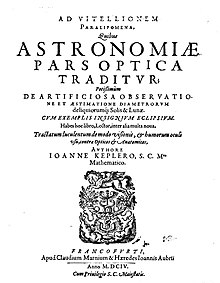

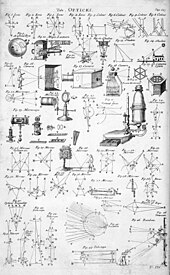
In the early 17th century,Johannes Keplerexpanded on geometric optics in his writings, covering lenses, reflection by flat and curved mirrors, the principles ofpinhole cameras,inverse-square law governing the intensity of light, and the optical explanations of astronomical phenomena such aslunarandsolar eclipsesand astronomicalparallax.He was also able to correctly deduce the role of theretinaas the actual organ that recorded images, finally being able to scientifically quantify the effects of different types of lenses that spectacle makers had been observing over the previous 300 years.[24]After the invention of the telescope, Kepler set out the theoretical basis on how they worked and described an improved version, known as theKeplerian telescope,using two convex lenses to produce higher magnification.[25]
Optical theory progressed in the mid-17th century withtreatiseswritten by philosopherRené Descartes,which explained a variety of optical phenomena including reflection and refraction by assuming that light was emitted by objects which produced it.[26]This differed substantively from the ancient Greek emission theory. In the late 1660s and early 1670s,Isaac Newtonexpanded Descartes's ideas into acorpuscle theory of light,famously determining that white light was a mix of colours that can be separated into its component parts with aprism.In 1690,Christiaan Huygensproposed a wave theory for light based on suggestions that had been made byRobert Hookein 1664. Hooke himself publicly criticised Newton's theories of light and the feud between the two lasted until Hooke's death. In 1704, Newton publishedOpticksand, at the time, partly because of his success in other areas of physics, he was generally considered to be the victor in the debate over the nature of light.[26]
Newtonian optics was generally accepted until the early 19th century whenThomas YoungandAugustin-Jean Fresnelconducted experiments on theinterferenceof light that firmly established light's wave nature. Young's famousdouble slit experimentshowed that light followed thesuperposition principle,which is a wave-like property not predicted by Newton's corpuscle theory. This work led to a theory of diffraction for light and opened an entire area of study in physical optics.[27]Wave optics was successfully unified withelectromagnetic theorybyJames Clerk Maxwellin the 1860s.[28]
The next development in optical theory came in 1899 whenMax Planckcorrectly modelledblackbody radiationby assuming that the exchange of energy between light and matter only occurred in discrete amounts he calledquanta.[29]In 1905,Albert Einsteinpublished the theory of thephotoelectric effectthat firmly established the quantization of light itself.[30][31]In 1913,Niels Bohrshowed that atoms could only emit discrete amounts of energy, thus explaining the discrete lines seen inemissionandabsorption spectra.[32]The understanding of the interaction between light and matter that followed from these developments not only formed the basis of quantum optics but also was crucial for thedevelopmentof quantum mechanics as a whole. The ultimate culmination, the theory ofquantum electrodynamics,explains all optics and electromagnetic processes in general as the result of the exchange of real andvirtualphotons.[33]Quantum optics gained practical importance with the inventions of themaserin 1953 and of the laser in 1960.[34]
Following the work ofPaul Diracinquantum field theory,George Sudarshan,Roy J. Glauber,andLeonard Mandelapplied quantum theory to the electromagnetic field in the 1950s and 1960s to gain a more detailed understanding of photodetection and thestatisticsof light.
Classical optics
[edit]
Classical optics is divided into two main branches: geometrical (or ray) optics and physical (or wave) optics. In geometrical optics, light is considered to travel in straight lines, while in physical optics, light is considered as an electromagnetic wave.
Geometrical optics can be viewed as an approximation of physical optics that applies when the wavelength of the light used is much smaller than the size of the optical elements in the system being modelled.
Geometrical optics
[edit]
Geometrical optics,orray optics,describes thepropagationof light in terms of "rays" which travel in straight lines, and whose paths are governed by the laws of reflection and refraction at interfaces between different media.[35]These laws were discovered empirically as far back as 984 AD[10]and have been used in the design of optical components and instruments from then until the present day. They can be summarised as follows:
When a ray of light hits the boundary between two transparent materials, it is divided into a reflected and a refracted ray.
- The law of reflection says that the reflected ray lies in the plane of incidence, and the angle of reflection equals the angle of incidence.
- The law of refraction says that the refracted ray lies in the plane of incidence, and the sine of the angle of incidence divided by the sine of the angle of refraction is a constant:wherenis a constant for any two materials and a given colour of light. If the first material is air or vacuum,nis therefractive indexof the second material.
The laws of reflection and refraction can be derived fromFermat's principlewhich states thatthe path taken between two points by a ray of light is the path that can be traversed in the least time.[36]
Approximations
[edit]Geometric optics is often simplified by making theparaxial approximation,or "small angle approximation". The mathematical behaviour then becomes linear, allowing optical components and systems to be described by simple matrices. This leads to the techniques ofGaussian opticsandparaxialray tracing,which are used to find basic properties of optical systems, such as approximateimageand object positions andmagnifications.[37]
Reflections
[edit]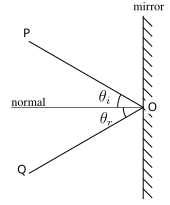
Reflections can be divided into two types:specular reflectionanddiffuse reflection.Specular reflection describes the gloss of surfaces such as mirrors, which reflect light in a simple, predictable way. This allows for the production of reflected images that can be associated with an actual (real) or extrapolated (virtual) location in space. Diffuse reflection describes non-glossy materials, such as paper or rock. The reflections from these surfaces can only be described statistically, with the exact distribution of the reflected light depending on the microscopic structure of the material. Many diffuse reflectors are described or can be approximated byLambert's cosine law,which describes surfaces that have equalluminancewhen viewed from any angle. Glossy surfaces can give both specular and diffuse reflection.
In specular reflection, the direction of the reflected ray is determined by the angle the incident ray makes with thesurface normal,a line perpendicular to the surface at the point where the ray hits. The incident and reflected rays and the normal lie in a single plane, and the angle between the reflected ray and the surface normal is the same as that between the incident ray and the normal.[38]This is known as theLaw of Reflection.
Forflat mirrors,the law of reflection implies that images of objects are upright and the same distance behind the mirror as the objects are in front of the mirror. The image size is the same as the object size. The law also implies thatmirror imagesare parity inverted, which we perceive as a left-right inversion. Images formed from reflection in two (or any even number of) mirrors are not parity inverted.Corner reflectorsproduce reflected rays that travel back in the direction from which the incident rays came.[39]This is calledretroreflection.
Mirrors with curved surfaces can be modelled by ray tracing and using the law of reflection at each point on the surface. Formirrors with parabolic surfaces,parallel rays incident on the mirror produce reflected rays that converge at a commonfocus.Other curved surfaces may also focus light, but with aberrations due to the diverging shape causing the focus to be smeared out in space. In particular, spherical mirrors exhibitspherical aberration.Curved mirrors can form images with a magnification greater than or less than one, and the magnification can be negative, indicating that the image is inverted. An upright image formed by reflection in a mirror is always virtual, while an inverted image is real and can be projected onto a screen.[40]
Refractions
[edit]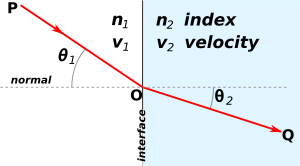
Refraction occurs when light travels through an area of space that has a changing index of refraction; this principle allows for lenses and the focusing of light. The simplest case of refraction occurs when there is aninterfacebetween a uniform medium with index of refractionn1and another medium with index of refractionn2.In such situations,Snell's Lawdescribes the resulting deflection of the light ray:
whereθ1andθ2are the angles between the normal (to the interface) and the incident and refracted waves, respectively.[38]
The index of refraction of a medium is related to the speed,v,of light in that medium by wherecis thespeed of light in vacuum.
Snell's Law can be used to predict the deflection of light rays as they pass through linear media as long as the indexes of refraction and the geometry of the media are known. For example, the propagation of light through a prism results in the light ray being deflected depending on the shape and orientation of the prism. In most materials, the index of refraction varies with the frequency of the light, known asdispersion.Taking this into account, Snell's Law can be used to predict how a prism will disperse light into a spectrum.[41]The discovery of this phenomenon when passing light through a prism is famously attributed to Isaac Newton.
Some media have an index of refraction which varies gradually with position and, therefore, light rays in the medium are curved. This effect is responsible formiragesseen on hot days: a change in index of refraction air with height causes light rays to bend, creating the appearance of specular reflections in the distance (as if on the surface of a pool of water). Optical materials with varying indexes of refraction are called gradient-index (GRIN) materials. Such materials are used to makegradient-index optics.[42]
For light rays travelling from a material with a high index of refraction to a material with a low index of refraction, Snell's law predicts that there is noθ2whenθ1is large. In this case, no transmission occurs; all the light is reflected. This phenomenon is calledtotal internal reflectionand allows for fibre optics technology. As light travels down an optical fibre, it undergoes total internal reflection allowing for essentially no light to be lost over the length of the cable.[43]
Lenses
[edit]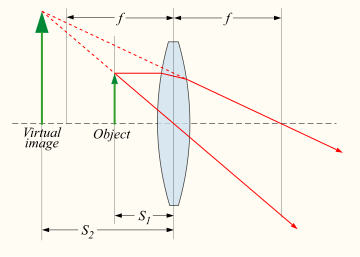
A device that produces converging or diverging light rays due to refraction is known as alens.Lenses are characterized by theirfocal length:a converging lens has positive focal length, while a diverging lens has negative focal length. Smaller focal length indicates that the lens has a stronger converging or diverging effect. The focal length of a simple lens in air is given by thelensmaker's equation.[44]
Ray tracing can be used to show how images are formed by a lens. For athin lensin air, the location of the image is given by the simple equation
whereS1is the distance from the object to the lens,θ2is the distance from the lens to the image, andfis the focal length of the lens. In thesign conventionused here, the object and image distances are positive if the object and image are on opposite sides of the lens.[45]

Incoming parallel rays are focused by a converging lens onto a spot one focal length from the lens, on the far side of the lens. This is called the rear focal point of the lens. Rays from an object at a finite distance are focused further from the lens than the focal distance; the closer the object is to the lens, the further the image is from the lens.
With diverging lenses, incoming parallel rays diverge after going through the lens, in such a way that they seem to have originated at a spot one focal length in front of the lens. This is the lens's front focal point. Rays from an object at a finite distance are associated with a virtual image that is closer to the lens than the focal point, and on the same side of the lens as the object. The closer the object is to the lens, the closer the virtual image is to the lens. As with mirrors, upright images produced by a single lens are virtual, while inverted images are real.[46]
Lenses suffer fromaberrationsthat distort images.Monochromatic aberrationsoccur because the geometry of the lens does not perfectly direct rays from each object point to a single point on the image, whilechromatic aberrationoccurs because the index of refraction of the lens varies with the wavelength of the light.[47]
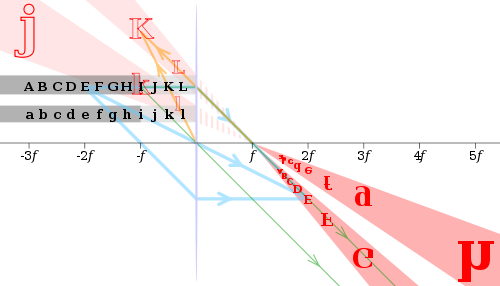
Physical optics
[edit]In physical optics, light is considered to propagate as waves. This model predicts phenomena such as interference and diffraction, which are not explained by geometric optics. Thespeed of lightwaves inairis approximately 3.0×108m/s (exactly 299,792,458 m/s invacuum). Thewavelengthof visible light waves varies between 400 and 700 nm, but the term "light" is also often applied to infrared (0.7–300 μm) and ultraviolet radiation (10–400 nm).
The wave model can be used to make predictions about how an optical system will behave without requiring an explanation of what is "waving" in what medium. Until the middle of the 19th century, most physicists believed in an "ethereal" medium in which the light disturbance propagated.[48]The existence of electromagnetic waves was predicted in 1865 byMaxwell's equations.These waves propagate at the speed of light and have varying electric and magnetic fields which are orthogonal to one another, and also to the direction of propagation of the waves.[49]Light waves are now generally treated as electromagnetic waves except whenquantum mechanical effectshave to be considered.
Modelling and design of optical systems using physical optics
[edit]Many simplified approximations are available for analysing and designing optical systems. Most of these use a singlescalarquantity to represent the electric field of the light wave, rather than using avectormodel with orthogonal electric and magnetic vectors.[50] TheHuygens–Fresnelequation is one such model. This was derived empirically by Fresnel in 1815, based on Huygens' hypothesis that each point on a wavefront generates a secondary spherical wavefront, which Fresnel combined with the principle ofsuperpositionof waves. TheKirchhoff diffraction equation,which is derived using Maxwell's equations, puts the Huygens-Fresnel equation on a firmer physical foundation. Examples of the application of Huygens–Fresnel principle can be found in the articles on diffraction andFraunhofer diffraction.
More rigorous models, involving the modelling of both electric and magnetic fields of the light wave, are required when dealing with materials whose electric and magnetic properties affect the interaction of light with the material. For instance, the behaviour of a light wave interacting with a metal surface is quite different from what happens when it interacts with a dielectric material. A vector model must also be used to model polarised light.
Numerical modelingtechniques such as thefinite element method,theboundary element methodand thetransmission-line matrix methodcan be used to model the propagation of light in systems which cannot be solved analytically. Such models are computationally demanding and are normally only used to solve small-scale problems that require accuracy beyond that which can be achieved with analytical solutions.[51]
All of the results from geometrical optics can be recovered using the techniques ofFourier opticswhich apply many of the same mathematical and analytical techniques used inacoustic engineeringandsignal processing.
Gaussian beam propagationis a simple paraxial physical optics model for the propagation of coherent radiation such as laser beams. This technique partially accounts for diffraction, allowing accurate calculations of the rate at which a laser beam expands with distance, and the minimum size to which the beam can be focused. Gaussian beam propagation thus bridges the gap between geometric and physical optics.[52]
Superposition and interference
[edit]In the absence ofnonlineareffects, the superposition principle can be used to predict the shape of interacting waveforms through the simple addition of the disturbances.[53]This interaction of waves to produce a resulting pattern is generally termed "interference" and can result in a variety of outcomes. If two waves of the same wavelength and frequency areinphase,both the wave crests and wave troughs align. This results inconstructive interferenceand an increase in the amplitude of the wave, which for light is associated with a brightening of the waveform in that location. Alternatively, if the two waves of the same wavelength and frequency are out of phase, then the wave crests will align with wave troughs and vice versa. This results indestructive interferenceand a decrease in the amplitude of the wave, which for light is associated with a dimming of the waveform at that location. See below for an illustration of this effect.[54]
| combined waveform |

| |
| wave 1 | ||
| wave 2 | ||
| Two waves in phase | Two waves 180° out of phase | |

Since the Huygens–Fresnel principle states that every point of a wavefront is associated with the production of a new disturbance, it is possible for a wavefront to interfere with itself constructively or destructively at different locations producing bright and dark fringes in regular and predictable patterns.[55]Interferometryis the science of measuring these patterns, usually as a means of making precise determinations of distances orangular resolutions.[56]TheMichelson interferometerwas a famous instrument which used interference effects to accurately measure the speed of light.[57]
The appearance ofthin films and coatingsis directly affected by interference effects.Antireflective coatingsuse destructive interference to reduce the reflectivity of the surfaces they coat, and can be used to minimise glare and unwanted reflections. The simplest case is a single layer with a thickness of one-fourth the wavelength of incident light. The reflected wave from the top of the film and the reflected wave from the film/material interface are then exactly 180° out of phase, causing destructive interference. The waves are only exactly out of phase for one wavelength, which would typically be chosen to be near the centre of the visible spectrum, around 550 nm. More complex designs using multiple layers can achieve low reflectivity over a broad band, or extremely low reflectivity at a single wavelength.
Constructive interference in thin films can create a strong reflection of light in a range of wavelengths, which can be narrow or broad depending on the design of the coating. These films are used to makedielectric mirrors,interference filters,heat reflectors,and filters for colour separation incolour televisioncameras. This interference effect is also what causes the colourful rainbow patterns seen in oil slicks.[58]
Diffraction and optical resolution
[edit]
Diffraction is the process by which light interference is most commonly observed. The effect was first described in 1665 byFrancesco Maria Grimaldi,who also coined the term from the Latindiffringere'to break into pieces'.[59][60]Later that century, Robert Hooke and Isaac Newton also described phenomena now known to be diffraction inNewton's rings[61]whileJames Gregoryrecorded his observations of diffraction patterns from bird feathers.[62]
The first physical optics model of diffraction that relied on the Huygens–Fresnel principle was developed in 1803 by Thomas Young in his interference experiments with the interference patterns of two closely spaced slits. Young showed that his results could only be explained if the two slits acted as two unique sources of waves rather than corpuscles.[63]In 1815 and 1818, Augustin-Jean Fresnel firmly established the mathematics of how wave interference can account for diffraction.[64]
The simplest physical models of diffraction use equations that describe the angular separation of light and dark fringes due to light of a particular wavelength (λ). In general, the equation takes the form wheredis the separation between two wavefront sources (in the case of Young's experiments, it wastwo slits),θis the angular separation between the central fringe and them-thorder fringe, where the central maximum ism= 0.[65]
This equation is modified slightly to take into account a variety of situations such as diffraction through a single gap, diffraction through multiple slits, or diffraction through adiffraction gratingthat contains a large number of slits at equal spacing.[66]More complicated models of diffraction require working with the mathematics ofFresnelorFraunhofer diffraction.[67]
X-ray diffractionmakes use of the fact that atoms in a crystal have regular spacing at distances that are on the order of oneangstrom.To see diffraction patterns, x-rays with similar wavelengths to that spacing are passed through the crystal. Since crystals are three-dimensional objects rather than two-dimensional gratings, the associated diffraction pattern varies in two directions according toBragg reflection,with the associated bright spots occurring inunique patternsanddbeing twice the spacing between atoms.[68]
Diffraction effects limit the ability of an optical detector tooptically resolveseparate light sources. In general, light that is passing through anaperturewill experience diffraction and the best images that can be created (as described indiffraction-limited optics) appear as a central spot with surrounding bright rings, separated by dark nulls; this pattern is known as anAiry pattern,and the central bright lobe as anAiry disk.[69]The size of such a disk is given bywhereθis the angular resolution,λis the wavelength of the light, andDis thediameterof the lens aperture. If the angular separation of the two points is significantly less than the Airy disk angular radius, then the two points cannot be resolved in the image, but if their angular separation is much greater than this, distinct images of the two points are formed and they can therefore be resolved.Rayleighdefined the somewhat arbitrary "Rayleigh criterion"that two points whose angular separation is equal to the Airy disk radius (measured to first null, that is, to the first place where no light is seen) can be considered to be resolved. It can be seen that the greater the diameter of the lens or its aperture, the finer the resolution.[70]Interferometry,with its ability to mimic extremely large baseline apertures, allows for the greatest angular resolution possible.[56]
For astronomical imaging, the atmosphere prevents optimal resolution from being achieved in the visible spectrum due to the atmosphericscatteringand dispersion which cause stars totwinkle.Astronomers refer to this effect as the quality ofastronomical seeing.Techniques known asadaptive opticshave been used to eliminate the atmospheric disruption of images and achieve results that approach the diffraction limit.[71]
Dispersion and scattering
[edit]
Refractive processes take place in the physical optics limit, where the wavelength of light is similar to other distances, as a kind of scattering. The simplest type of scattering isThomson scatteringwhich occurs when electromagnetic waves are deflected by single particles. In the limit of Thomson scattering, in which the wavelike nature of light is evident, light is dispersed independent of the frequency, in contrast toCompton scatteringwhich is frequency-dependent and strictly aquantum mechanicalprocess, involving the nature of light as particles. In a statistical sense, elastic scattering of light by numerous particles much smaller than the wavelength of the light is a process known asRayleigh scatteringwhile the similar process for scattering by particles that are similar or larger in wavelength is known asMie scatteringwith theTyndall effectbeing a commonly observed result. A small proportion of light scattering from atoms or molecules may undergoRaman scattering,wherein the frequency changes due to excitation of the atoms and molecules.Brillouin scatteringoccurs when the frequency of light changes due to local changes with time and movements of a dense material.[72]
Dispersion occurs when different frequencies of light have differentphase velocities,due either to material properties (material dispersion) or to the geometry of anoptical waveguide(waveguide dispersion). The most familiar form of dispersion is a decrease in index of refraction with increasing wavelength, which is seen in most transparent materials. This is called "normal dispersion". It occurs in alldielectric materials,in wavelength ranges where the material does not absorb light.[73]In wavelength ranges where a medium has significant absorption, the index of refraction can increase with wavelength. This is called "anomalous dispersion".[73]
The separation of colours by a prism is an example of normal dispersion. At the surfaces of the prism, Snell's law predicts that light incident at an angleθto the normal will be refracted at an anglearcsin(sin (θ) /n).Thus, blue light, with its higher refractive index, is bent more strongly than red light, resulting in the well-knownrainbowpattern.[41]

Material dispersion is often characterised by theAbbe number,which gives a simple measure of dispersion based on the index of refraction at three specific wavelengths. Waveguide dispersion is dependent on thepropagation constant.[74]Both kinds of dispersion cause changes in the group characteristics of the wave, the features of the wave packet that change with the same frequency as the amplitude of the electromagnetic wave. "Group velocity dispersion" manifests as a spreading-out of the signal "envelope" of the radiation and can be quantified with a group dispersion delay parameter:
wherevgis the group velocity.[75]For a uniform medium, the group velocity is
wherenis the index of refraction andcis the speed of light in a vacuum.[76]This gives a simpler form for the dispersion delay parameter:
IfDis less than zero, the medium is said to havepositive dispersionor normal dispersion. IfDis greater than zero, the medium hasnegative dispersion.If a light pulse is propagated through a normally dispersive medium, the result is the higher frequency components slow down more than the lower frequency components. The pulse therefore becomespositivelychirped,orup-chirped,increasing in frequency with time. This causes the spectrum coming out of a prism to appear with red light the least refracted and blue/violet light the most refracted. Conversely, if a pulse travels through an anomalously (negatively) dispersive medium, high-frequency components travel faster than the lower ones, and the pulse becomesnegatively chirped,ordown-chirped,decreasing in frequency with time.[77]
The result of group velocity dispersion, whether negative or positive, is ultimately temporal spreading of the pulse. This makes dispersion management extremely important in optical communications systems based onoptical fibres,since if dispersion is too high, a group of pulses representing information will each spread in time and merge, making it impossible to extract the signal.[75]
Polarisation
[edit]Polarisation is a general property of waves that describes the orientation of their oscillations. Fortransverse wavessuch as many electromagnetic waves, it describes the orientation of the oscillations in the plane perpendicular to the wave's direction of travel. The oscillations may be oriented in a single direction (linear polarisation), or the oscillation direction may rotate as the wave travels (circularorelliptical polarisation). Circularly polarised waves can rotate rightward or leftward in the direction of travel, and which of those two rotations is present in a wave is called the wave'schirality.[78]
The typical way to consider polarisation is to keep track of the orientation of the electric fieldvectoras the electromagnetic wave propagates. The electric field vector of a plane wave may be arbitrarily divided into two perpendicularcomponentslabeledxandy(withzindicating the direction of travel). The shape traced out in the x-y plane by the electric field vector is aLissajous figurethat describes thepolarisation state.[79]The following figures show some examples of the evolution of the electric field vector (blue), with time (the vertical axes), at a particular point in space, along with itsxandycomponents (red/left and green/right), and the path traced by the vector in the plane (purple): The same evolution would occur when looking at the electric field at a particular time while evolving the point in space, along the direction opposite to propagation.
In the leftmost figure above, thexandycomponents of the light wave are in phase. In this case, the ratio of their strengths is constant, so the direction of the electric vector (the vector sum of these two components) is constant. Since the tip of the vector traces out a single line in the plane, this special case is called linear polarisation. The direction of this line depends on the relative amplitudes of the two components.[80]
In the middle figure, the two orthogonal components have the same amplitudes and are 90° out of phase. In this case, one component is zero when the other component is at maximum or minimum amplitude. There are two possible phase relationships that satisfy this requirement: thexcomponent can be 90° ahead of theycomponent or it can be 90° behind theycomponent. In this special case, the electric vector traces out a circle in the plane, so this polarisation is called circular polarisation. The rotation direction in the circle depends on which of the two-phase relationships exists and corresponds toright-hand circular polarisationandleft-hand circular polarisation.[81]
In all other cases, where the two components either do not have the same amplitudes and/or their phase difference is neither zero nor a multiple of 90°, the polarisation is called elliptical polarisation because the electric vector traces out anellipsein the plane (thepolarisation ellipse).[82]This is shown in the above figure on the right. Detailed mathematics of polarisation is done usingJones calculusand is characterised by theStokes parameters.[83]
Changing polarisation
[edit]Media that have different indexes of refraction for different polarisation modes are calledbirefringent.[84]Well known manifestations of this effect appear in opticalwave plates/retarders (linear modes) and inFaraday rotation/optical rotation(circular modes).[85]If the path length in the birefringent medium is sufficient, plane waves will exit the material with a significantly different propagation direction, due to refraction. For example, this is the case with macroscopic crystals ofcalcite,which present the viewer with two offset, orthogonally polarised images of whatever is viewed through them. It was this effect that provided the first discovery of polarisation, byErasmus Bartholinusin 1669. In addition, the phase shift, and thus the change in polarisation state, is usually frequency dependent, which, in combination withdichroism,often gives rise to bright colours and rainbow-like effects. Inmineralogy,such properties, known aspleochroism,are frequently exploited for the purpose of identifying minerals using polarisation microscopes. Additionally, many plastics that are not normally birefringent will become so when subject tomechanical stress,a phenomenon which is the basis ofphotoelasticity.[86]Non-birefringent methods, to rotate the linear polarisation of light beams, include the use of prismaticpolarisation rotatorswhich use total internal reflection in a prism set designed for efficient collinear transmission.[87]

Media that reduce the amplitude of certain polarisation modes are calleddichroic,with devices that block nearly all of the radiation in one mode known aspolarising filtersor simply "polarisers".Malus' law, which is named afterÉtienne-Louis Malus,says that when a perfect polariser is placed in a linear polarised beam of light, the intensity,I,of the light that passes through is given by
whereI0is the initial intensity, andθiis the angle between the light's initial polarisation direction and the axis of the polariser.[88]
A beam of unpolarised light can be thought of as containing a uniform mixture of linear polarisations at all possible angles. Since the average value ofcos2θis 1/2, the transmission coefficient becomes
In practice, some light is lost in the polariser and the actual transmission of unpolarised light will be somewhat lower than this, around 38% for Polaroid-type polarisers but considerably higher (>49.9%) for some birefringent prism types.[89]
In addition to birefringence and dichroism in extended media, polarisation effects can also occur at the (reflective) interface between two materials of different refractive index. These effects are treated by theFresnel equations.Part of the wave is transmitted and part is reflected, with the ratio depending on the angle of incidence and the angle of refraction. In this way, physical optics recoversBrewster's angle.[90]When light reflects from athin filmon a surface, interference between the reflections from the film's surfaces can produce polarisation in the reflected and transmitted light.
Natural light
[edit]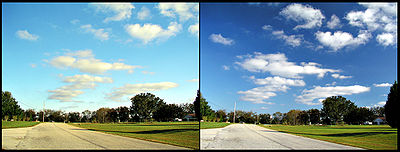
Most sources of electromagnetic radiation contain a large number of atoms or molecules that emit light. The orientation of the electric fields produced by these emitters may not becorrelated,in which case the light is said to beunpolarised.If there is partial correlation between the emitters, the light ispartially polarised.If the polarisation is consistent across the spectrum of the source, partially polarised light can be described as a superposition of a completely unpolarised component, and a completely polarised one. One may then describe the light in terms of thedegree of polarisation,and the parameters of the polarisation ellipse.[79]
Light reflected by shiny transparent materials is partly or fully polarised, except when the light is normal (perpendicular) to the surface. It was this effect that allowed the mathematician Étienne-Louis Malus to make the measurements that allowed for his development of the first mathematical models for polarised light. Polarisation occurs when light is scattered in theatmosphere.The scattered light produces the brightness and colour in clearskies.This partial polarisation of scattered light can be taken advantage of using polarising filters to darken the sky inphotographs.Optical polarisation is principally of importance inchemistrydue tocircular dichroismand optical rotation (circular birefringence) exhibited byoptically active(chiral)molecules.[91]
Modern optics
[edit]Modern opticsencompasses the areas of optical science and engineering that became popular in the 20th century. These areas of optical science typically relate to the electromagnetic or quantum properties of light but do include other topics. A major subfield of modern optics,quantum optics,deals with specifically quantum mechanical properties of light. Quantum optics is not just theoretical; some modern devices, such as lasers, have principles of operation that depend on quantum mechanics. Light detectors, such asphotomultipliersandchanneltrons,respond to individual photons. Electronicimage sensors,such asCCDs,exhibitshot noisecorresponding to the statistics of individual photon events.Light-emitting diodesandphotovoltaic cells,too, cannot be understood without quantum mechanics. In the study of these devices, quantum optics often overlaps withquantum electronics.[92]
Specialty areas of optics research include the study of how light interacts with specific materials as incrystal opticsandmetamaterials.Other research focuses on the phenomenology of electromagnetic waves as insingular optics,non-imaging optics,non-linear optics,statistical optics, andradiometry.Additionally,computer engineershave taken an interest inintegrated optics,machine vision,andphotonic computingas possible components of the "next generation" of computers.[93]
Today, the pure science of optics is called optical science oroptical physicsto distinguish it from applied optical sciences, which are referred to asoptical engineering.Prominent subfields of optical engineering includeillumination engineering,photonics,andoptoelectronicswith practical applications likelens design,fabrication and testing of optical components,andimage processing.Some of these fields overlap, with nebulous boundaries between the subjects' terms that mean slightly different things in different parts of the world and in different areas of industry. A professional community of researchers in nonlinear optics has developed in the last several decades due to advances in laser technology.[94]
Lasers
[edit]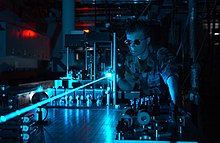
A laser is a device that emits light, a kind of electromagnetic radiation, through a process calledstimulated emission.The termlaseris anacronymfor'Light Amplification by Stimulated Emission of Radiation'.[95]Laser light is usually spatiallycoherent,which means that the light either is emitted in a narrow,low-divergence beam,or can be converted into one with the help of optical components such as lenses. Because the microwave equivalent of the laser, themaser,was developed first, devices that emit microwave andradiofrequencies are usually calledmasers.[96]
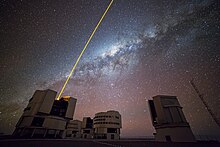
The first working laser was demonstrated on 16 May 1960 byTheodore MaimanatHughes Research Laboratories.[98]When first invented, they were called "a solution looking for a problem".[99]Since then, lasers have become a multibillion-dollar industry, finding utility in thousands of highly varied applications. The first application of lasers visible in the daily lives of the general population was the supermarketbarcodescanner, introduced in 1974.[100]Thelaserdiscplayer, introduced in 1978, was the first successful consumer product to include a laser, but thecompact discplayer was the first laser-equipped device to become truly common in consumers' homes, beginning in 1982.[101]Theseoptical storagedevices use asemiconductor laserless than a millimetre wide to scan the surface of the disc for data retrieval.Fibre-optic communicationrelies on lasers to transmit large amounts of information at the speed of light. Other common applications of lasers includelaser printersandlaser pointers.Lasers are used in medicine in areas such asbloodless surgery,laser eye surgery,andlaser capture microdissectionand in military applications such asmissile defence systems,electro-optical countermeasures (EOCM),andlidar.Lasers are also used inholograms,bubblegrams,laser light shows,andlaser hair removal.[102]
Kapitsa–Dirac effect
[edit]TheKapitsa–Dirac effectcauses beams of particles to diffract as the result of meeting a standing wave of light. Light can be used to position matter using various phenomena (seeoptical tweezers).
Applications
[edit]Optics is part of everyday life. The ubiquity ofvisual systemsin biology indicates the central role optics plays as the science of one of thefive senses.Many people benefit fromeyeglassesorcontact lenses,and optics are integral to the functioning of many consumer goods includingcameras.Rainbows and mirages are examples of optical phenomena.Optical communicationprovides the backbone for both theInternetand moderntelephony.
Human eye
[edit]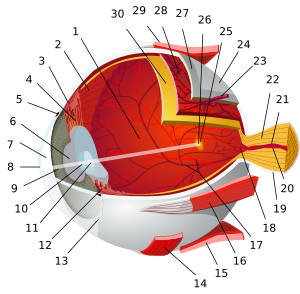

The human eye functions by focusing light onto a layer ofphotoreceptor cellscalled the retina, which forms the inner lining of the back of the eye. The focusing is accomplished by a series of transparent media. Light entering the eye passes first through the cornea, which provides much of the eye's optical power. The light then continues through the fluid just behind the cornea—theanterior chamber,then passes through thepupil.The light then passes through thelens,which focuses the light further and allows adjustment of focus. The light then passes through the main body of fluid in the eye—thevitreous humour,and reaches the retina. The cells in the retina line the back of the eye, except for where the optic nerve exits; this results in ablind spot.
There are two types of photoreceptor cells, rods and cones, which are sensitive to different aspects of light.[103]Rod cells are sensitive to the intensity of light over a wide frequency range, thus are responsible forblack-and-white vision.Rod cells are not present on the fovea, the area of the retina responsible for central vision, and are not as responsive as cone cells to spatial and temporal changes in light. There are, however, twenty times more rod cells than cone cells in the retina because the rod cells are present across a wider area. Because of their wider distribution, rods are responsible forperipheral vision.[104]
In contrast, cone cells are less sensitive to the overall intensity of light, but come in three varieties that are sensitive to different frequency-ranges and thus are used in the perception ofcolourandphotopic vision.Cone cells are highly concentrated in the fovea and have a high visual acuity meaning that they are better at spatial resolution than rod cells. Since cone cells are not as sensitive to dim light as rod cells, mostnight visionis limited to rod cells. Likewise, since cone cells are in the fovea, central vision (including the vision needed to do most reading, fine detail work such as sewing, or careful examination of objects) is done by cone cells.[104]
Ciliary muscles around the lens allow the eye's focus to be adjusted. This process is known asaccommodation.Thenear pointandfar pointdefine the nearest and farthest distances from the eye at which an object can be brought into sharp focus. For a person with normal vision, the far point is located at infinity. The near point's location depends on how much the muscles can increase the curvature of the lens, and how inflexible the lens has become with age.Optometrists,ophthalmologists,andopticiansusually consider an appropriate near point to be closer than normal reading distance—approximately 25 cm.[103]
Defects in vision can be explained using optical principles. As people age, the lens becomes less flexible and the near point recedes from the eye, a condition known aspresbyopia.Similarly, people suffering fromhyperopiacannot decrease the focal length of their lens enough to allow for nearby objects to be imaged on their retina. Conversely, people who cannot increase the focal length of their lens enough to allow for distant objects to be imaged on the retina suffer frommyopiaand have a far point that is considerably closer than infinity. A condition known asastigmatismresults when the cornea is not spherical but instead is more curved in one direction. This causes horizontally extended objects to be focused on different parts of the retina than vertically extended objects, and results in distorted images.[103]
All of these conditions can be corrected usingcorrective lenses.For presbyopia and hyperopia, aconverging lensprovides the extra curvature necessary to bring the near point closer to the eye while for myopia adiverging lensprovides the curvature necessary to send the far point to infinity. Astigmatism is corrected with acylindrical surfacelens that curves more strongly in one direction than in another, compensating for the non-uniformity of the cornea.[105]
The optical power of corrective lenses is measured indiopters,a value equal to thereciprocalof the focal length measured in metres; with a positive focal length corresponding to a converging lens and a negative focal length corresponding to a diverging lens. For lenses that correct for astigmatism as well, three numbers are given: one for the spherical power, one for the cylindrical power, and one for the angle of orientation of the astigmatism.[105]
Visual effects
[edit]
Optical illusions (also called visual illusions) are characterized by visually perceived images that differ from objective reality. The information gathered by the eye is processed in the brain to give aperceptthat differs from the object being imaged. Optical illusions can be the result of a variety of phenomena including physical effects that create images that are different from the objects that make them, the physiological effects on the eyes and brain of excessive stimulation (e.g. brightness, tilt, colour, movement), and cognitive illusions where the eye and brain makeunconscious inferences.[106]
Cognitive illusions include some which result from the unconscious misapplication of certain optical principles. For example, theAmes room,Hering,Müller-Lyer,Orbison,Ponzo,Sander,andWundt illusionsall rely on the suggestion of the appearance of distance by using converging and diverging lines, in the same way that parallel light rays (or indeed any set of parallel lines) appear to converge at avanishing pointat infinity in two-dimensionally rendered images with artistic perspective.[107]This suggestion is also responsible for the famousmoon illusionwhere the moon, despite having essentially the same angular size, appears much larger near thehorizonthan it does atzenith.[108]This illusion so confoundedPtolemythat he incorrectly attributed it to atmospheric refraction when he described it in his treatise,Optics.[8]
Another type of optical illusion exploits broken patterns to trick the mind into perceiving symmetries or asymmetries that are not present. Examples include thecafé wall,Ehrenstein,Fraser spiral,Poggendorff,andZöllner illusions.Related, but not strictly illusions, are patterns that occur due to the superimposition of periodic structures. For example,transparenttissues with a grid structure produce shapes known asmoiré patterns,while the superimposition of periodic transparent patterns comprising parallel opaque lines or curves producesline moirépatterns.[109]
Optical instruments
[edit]
Single lenses have a variety of applications includingphotographic lenses,corrective lenses, and magnifying glasses while single mirrors are used in parabolic reflectors andrear-view mirrors.Combining a number of mirrors, prisms, and lenses produces compound optical instruments which have practical uses. For example, aperiscopeis simply two plane mirrors aligned to allow for viewing around obstructions. The most famous compound optical instruments in science are the microscope and the telescope which were both invented by the Dutch in the late 16th century.[110]
Microscopes were first developed with just two lenses: anobjective lensand aneyepiece.The objective lens is essentially a magnifying glass and was designed with a very small focal length while the eyepiece generally has a longer focal length. This has the effect of producing magnified images of close objects. Generally, an additional source of illumination is used since magnified images are dimmer due to theconservation of energyand the spreading of light rays over a larger surface area. Modern microscopes, known ascompound microscopeshave many lenses in them (typically four) to optimize the functionality and enhance image stability.[111]A slightly different variety of microscope, thecomparison microscope,looks at side-by-side images to produce astereoscopicbinocularview that appears three dimensional when used by humans.[112]
The first telescopes, called refracting telescopes, were also developed with a single objective and eyepiece lens. In contrast to the microscope, the objective lens of the telescope was designed with a large focal length to avoid optical aberrations. The objective focuses an image of a distant object at its focal point which is adjusted to be at the focal point of an eyepiece of a much smaller focal length. The main goal of a telescope is not necessarily magnification, but rather the collection of light which is determined by the physical size of the objective lens. Thus, telescopes are normally indicated by the diameters of their objectives rather than by the magnification which can be changed by switching eyepieces. Because the magnification of a telescope is equal to the focal length of the objective divided by the focal length of the eyepiece, smaller focal-length eyepieces cause greater magnification.[113]
Since crafting large lenses is much more difficult than crafting large mirrors, most modern telescopes arereflecting telescopes,that is, telescopes that use a primary mirror rather than an objective lens. The same general optical considerations apply to reflecting telescopes that applied to refracting telescopes, namely, the larger the primary mirror, the more light collected, and the magnification is still equal to the focal length of the primary mirror divided by the focal length of the eyepiece. Professional telescopes generally do not have eyepieces and instead place an instrument (often a charge-coupled device) at the focal point instead.[114]
Photography
[edit]

The optics of photography involves both lenses and the medium in which the electromagnetic radiation is recorded, whether it be aplate,film,or charge-coupled device. Photographers must consider thereciprocityof the camera and the shot which is summarized by the relation
- Exposure ∝ ApertureArea × ExposureTime × SceneLuminance[115]
In other words, the smaller the aperture (giving greater depth of focus), the less light coming in, so the length of time has to be increased (leading to possible blurriness if motion occurs). An example of the use of the law of reciprocity is theSunny 16 rulewhich gives a rough estimate for the settings needed to estimate the properexposurein daylight.[116]
A camera's aperture is measured by a unitless number called thef-numberor f-stop,f/#, often notated as,and given by
whereis the focal length, andis the diameter of the entrance pupil. By convention, "f/# "is treated as a single symbol, and specific values off/# are written by replacing thenumber signwith the value. The two ways to increase the f-stop are to either decrease the diameter of the entrance pupil or change to a longer focal length (in the case of azoom lens,this can be done by simply adjusting the lens). Higher f-numbers also have a largerdepth of fielddue to the lens approaching the limit of a pinhole camera which is able to focus all images perfectly, regardless of distance, but requires very long exposure times.[117]
The field of view that the lens will provide changes with the focal length of the lens. There are three basic classifications based on the relationship to the diagonal size of the film or sensor size of the camera to the focal length of the lens:[118]
- Normal lens:angle of view of about 50° (callednormalbecause this angle considered roughly equivalent to human vision[118]) and a focal length approximately equal to the diagonal of the film or sensor.[119]
- Wide-angle lens:angle of view wider than 60° and focal length shorter than a normal lens.[120]
- Long focus lens:angle of view narrower than a normal lens. This is any lens with a focal length longer than the diagonal measure of the film or sensor.[121]The most common type of long focus lens is thetelephoto lens,a design that uses a specialtelephoto groupto be physically shorter than its focal length.[122]
Modern zoom lenses may have some or all of these attributes.
The absolute value for the exposure time required depends on howsensitiveto light the medium being used is (measured by thefilm speed,or, for digital media, by thequantum efficiency).[123]Early photography used media that had very low light sensitivity, and so exposure times had to be long even for very bright shots. As technology has improved, so has the sensitivity through film cameras and digital cameras.[124]
Other results from physical and geometrical optics apply to camera optics. For example, the maximum resolution capability of a particular camera set-up is determined by thediffraction limitassociated with the pupil size and given, roughly, by the Rayleigh criterion.[125]
Atmospheric optics
[edit]
The unique optical properties of the atmosphere cause a wide range of spectacular optical phenomena. The blue colour of the sky is a direct result of Rayleigh scattering which redirects higher frequency (blue) sunlight back into the field of view of the observer. Because blue light is scattered more easily than red light, the sun takes on a reddish hue when it is observed through a thick atmosphere, as during asunriseorsunset.Additional particulate matter in the sky can scatter different colours at different angles creating colourful glowing skies at dusk and dawn. Scattering off of ice crystals and other particles in the atmosphere are responsible forhalos,afterglows,coronas,rays of sunlight,andsun dogs.The variation in these kinds of phenomena is due to different particle sizes and geometries.[126]
Mirages are optical phenomena in which light rays are bent due to thermal variations in the refraction index of air, producing displaced or heavily distorted images of distant objects. Other dramatic optical phenomena associated with this include theNovaya Zemlya effectwhere the sun appears to rise earlier than predicted with a distorted shape. A spectacular form of refraction occurs with atemperature inversioncalled theFata Morganawhere objects on the horizon or even beyond the horizon, such as islands, cliffs, ships or icebergs, appear elongated and elevated, like "fairy tale castles".[127]
Rainbows are the result of a combination of internal reflection and dispersive refraction of light in raindrops. A single reflection off the backs of an array of raindrops produces a rainbow with an angular size on the sky that ranges from 40° to 42° with red on the outside. Double rainbows are produced by two internal reflections with angular size of 50.5° to 54° with violet on the outside. Because rainbows are seen with the sun 180° away from the centre of the rainbow, rainbows are more prominent the closer the sun is to the horizon.[128]
See also
[edit]- Ion optics
- Important publications in optics
- List of optical topics
- List of textbooks in electromagnetism
References
[edit]- ^abMcGraw-Hill Encyclopedia of Science and Technology(5th ed.). McGraw-Hill. 1993.
- ^"World's oldest telescope?".BBC News.July 1, 1999.Archivedfrom the original on February 1, 2009.RetrievedJan 3,2010.
- ^T.F. Hoad (1996).The Concise Oxford Dictionary of English Etymology.ISBN978-0-19-283098-2.
- ^A History Of The EyeArchived2012-01-20 at theWayback Machine.stanford.edu. Retrieved 2012-06-10.
- ^T.L. Heath (2003).A manual of greek mathematics.Courier Dover Publications. pp. 181–182.ISBN978-0-486-43231-1.
- ^William R. Uttal (1983).Visual Form Detection in 3-Dimensional Space.Psychology Press. pp. 25–.ISBN978-0-89859-289-4.Archivedfrom the original on 2016-05-03.
- ^Euclid (1999). Elaheh Kheirandish (ed.).The Arabic version of Euclid's optics = Kitāb Uqlīdis fī ikhtilāf al-manāẓir.New York: Springer.ISBN978-0-387-98523-7.
- ^abPtolemy (1996). A. Mark Smith (ed.).Ptolemy's theory of visual perception: an English translation of the Optics with introduction and commentary.DIANE Publishing.ISBN978-0-87169-862-9.
- ^Adamson, Peter (2006). "Al-Kindi¯ and the reception of Greek philosophy". In Adamson, Peter; Taylor, R.. The Cambridge companion to Arabic philosophy. Cambridge University Press. p. 45.ISBN978-0-521-52069-0.
- ^abRashed, Roshdi (1990). "A pioneer in anaclastics: Ibn Sahl on burning mirrors and lenses".Isis.81(3): 464–491.doi:10.1086/355456.JSTOR233423.S2CID144361526.
- ^
- Hogendijk, Jan P.; Sabra, Abdelhamid I., eds. (2003).The Enterprise of Science in Islam: New Perspectives.MIT Press. pp. 85–118.ISBN978-0-262-19482-2.OCLC50252039.
- G. Hatfield (1996). "Was the Scientific Revolution Really a Revolution in Science?". In F.J. Ragep; P. Sally; S.J. Livesey (eds.).Tradition, Transmission, Transformation: Proceedings of Two Conferences on Pre-modern Science held at the University of Oklahoma.Brill Publishers. p. 500.ISBN978-90-04-10119-7.Archivedfrom the original on 2016-04-27.
- Nader El-Bizri (2005). "A Philosophical Perspective on Alhazen's Optics".Arabic Sciences and Philosophy.15(2): 189–218.doi:10.1017/S0957423905000172.S2CID123057532.
- Nader El-Bizri (2007). "In Defence of the Sovereignty of Philosophy: al-Baghdadi's Critique of Ibn al-Haytham's Geometrisation of Place".Arabic Sciences and Philosophy.17:57–80.doi:10.1017/S0957423907000367.S2CID170960993.
- G. Simon (2006). "The Gaze in Ibn al-Haytham".The Medieval History Journal.9:89–98.doi:10.1177/097194580500900105.S2CID170628785.
- ^Ian P. Howard; Brian J. Rogers (1995).Binocular Vision and Stereopsis.Oxford University Press. p. 7.ISBN978-0-19-508476-4.Archivedfrom the original on 2016-05-06.
- ^Elena Agazzi; Enrico Giannetto; Franco Giudice (2010).Representing Light Across Arts and Sciences: Theories and Practices.V&R unipress GmbH. p. 42.ISBN978-3-89971-735-8.Archivedfrom the original on 2016-05-10.
- ^El-Bizri, Nader(2010). "Classical Optics and the Perspectiva Traditions Leading to the Renaissance". InHendrix, John Shannon;Carman, Charles H. (eds.).Renaissance Theories of Vision (Visual Culture in Early Modernity).Farnham, Surrey:Ashgate Publishing.pp. 11–30.ISBN978-1-4094-0024-0.;El-Bizri, Nader(2014). "Seeing Reality in Perspective: 'The Art of Optics' and the 'Science of Painting'".In Lupacchini, Rossella; Angelini, Annarita (eds.).The Art of Science: From Perspective Drawing to Quantum Randomness.Doredrecht: Springer. pp. 25–47.
- ^D.C. Lindberg,Theories of Vision from al-Kindi to Kepler,(Chicago: Univ. of Chicago Pr., 1976), pp. 94–99.
- ^Ilardi, Vincent (2007).Renaissance Vision from Spectacles to Telescopes.Philadelphia: American Philosophical Society. pp. 4–5.ISBN978-0-87169-259-7.
- ^"The Galileo Project > Science > The Telescope" by Al Van HeldenArchived2012-03-20 at theWayback Machine.Galileo.rice.edu. Retrieved 2012-06-10.
- ^Henry C. King (2003).The History of the Telescope.Courier Dover Publications. p. 27.ISBN978-0-486-43265-6.Archivedfrom the original on 2016-06-17.
- ^Paul S. Agutter; Denys N. Wheatley (2008).Thinking about Life: The History and Philosophy of Biology and Other Sciences.Springer. p. 17.ISBN978-1-4020-8865-0.Archivedfrom the original on 2016-05-16.
- ^Ilardi (2007),p.210.
- ^Microscopes: Time LineArchived2010-01-09 at theWayback Machine,Nobel Foundation. Retrieved April 3, 2009
- ^Watson, Fred (2007).Stargazer: The Life and Times of the Telescope.Allen & Unwin. p. 55.ISBN978-1-74175-383-7.Archivedfrom the original on 2016-05-08.
- ^Caspar, Max (1993) [First published 1959].Kepler.Dover Publications. pp. 142–146.ISBN0-486-67605-6.
- ^Ilardi (2007),p.244.
- ^Caspar (1993),pp.192–202.
- ^abA.I. Sabra (1981).Theories of light, from Descartes to Newton.CUP Archive.ISBN978-0-521-28436-3.
- ^W.F. Magie (1935).A Source Book in Physics.Harvard University Press. p.309.
- ^J.C. Maxwell (1865)."A Dynamical Theory of the Electromagnetic Field".Philosophical Transactions of the Royal Society of London.155:459–512.Bibcode:1865RSPT..155..459C.doi:10.1098/rstl.1865.0008.S2CID186207827.
- ^For a solid approach to the complexity of Planck's intellectual motivations for the quantum, for his reluctant acceptance of its implications, see H. Kragh,Max Planck: the reluctant revolutionaryArchived2012-04-01 at theWayback Machine,Physics World.December 2000.
- ^Einstein, A.(1967). "On a heuristic viewpoint concerning the production and transformation of light". In Ter Haar, D. (ed.).The Old Quantum Theory.Pergamon. pp.91–107.OCLC534625.The chapter is an English translation of Einstein's 1905 paper on the photoelectric effect.
- ^Einstein, A. (1905)."Über einen die Erzeugung und Verwandlung des Lichtes betreffenden heuristischen Gesichtspunkt"[On a heuristic viewpoint concerning the production and transformation of light].Annalen der Physik(in German).322(6): 132–148.Bibcode:1905AnP...322..132E.doi:10.1002/andp.19053220607.
- ^"On the Constitution of Atoms and Molecules".Philosophical Magazine.26, Series 6: 1–25. 1913. Archived fromthe originalon July 4, 2007..The landmark paper laying theBohr model of the atomandmolecular bonding.
- ^R. Feynman(1985). "Chapter 1".QED: The Strange Theory of Light and Matter.Princeton University Press. p. 6.ISBN978-0-691-08388-9.
- ^N. Taylor (2000).LASER: The inventor, the Nobel laureate, and the thirty-year patent war.New York: Simon & Schuster.ISBN978-0-684-83515-0.
- ^Ariel Lipson; Stephen G. Lipson; Henry Lipson (28 October 2010).Optical Physics.Cambridge University Press. p. 48.ISBN978-0-521-49345-1.Archivedfrom the original on 28 May 2013.Retrieved12 July2012.
- ^Arthur Schuster (1904).An Introduction to the Theory of Optics.E. Arnold. p.41.
- ^J.E. Greivenkamp (2004).Field Guide to Geometrical Optics. SPIE Field Guides vol.FG01.SPIE. pp. 19–20.ISBN978-0-8194-5294-8.
- ^abYoung & Freedman (2020),p. 1109.
- ^Young & Freedman (2020),pp. 1112–1113.
- ^Young & Freedman (2020),pp. 1142–1143, 1145.
- ^abYoung & Freedman (2020),p. 1116.
- ^Marchand, E.W. (1978).Gradient Index Optics.New York: Academic Press.
- ^Young & Freedman (2020),pp. 1113–1115.
- ^Hecht (2017),p. 159.
- ^Hecht (2017),p. 165.
- ^Young & Freedman (2020),p. 1157.
- ^Young & Freedman (2020),p. 1143,1163,1175.
- ^MV Klein & TE Furtak, 1986, Optics, John Wiley & Sons, New YorkISBN0-471-87297-0.
- ^Maxwell, James Clerk(1865)."A dynamical theory of the electromagnetic field"(PDF).Philosophical Transactions of the Royal Society of London.155:499.Bibcode:1865RSPT..155..459C.doi:10.1098/rstl.1865.0008.S2CID186207827.Archived(PDF)from the original on 2011-07-28.This article accompanied a December 8, 1864, presentation by Maxwell to the Royal Society. See alsoA dynamical theory of the electromagnetic field.
- ^M. Born and E. Wolf (1999).Principle of Optics.Cambridge: Cambridge University Press.ISBN0-521-64222-1.
- ^J. Goodman (2005).Introduction to Fourier Optics(3rd ed.). Roberts & Co Publishers.ISBN978-0-9747077-2-3.
- ^A.E. Siegman (1986).Lasers.University Science Books.ISBN978-0-935702-11-8.Chapter 16.
- ^Young & Freedman (2020),pp. 1187–1188.
- ^Young & Freedman (2020),p. 512, 1189.
- ^Young & Freedman (2020),pp. 1191–1192.
- ^abP. Hariharan (2003).Optical Interferometry(PDF)(2nd ed.). San Diego, US: Academic Press.ISBN978-0-12-325220-3.Archived(PDF)from the original on 2008-04-06.
- ^E.R. Hoover (1977).Cradle of Greatness: National and World Achievements of Ohio's Western Reserve.Cleveland: Shaker Savings Association.
- ^Young & Freedman (2020),pp. 1198–1200.
- ^Aubert, J. L. (1760).Memoires pour l'histoire des sciences et des beaux arts[Memoirs for the history of science and fine arts] (in French). Paris: Impr. de S.A.S.; Chez E. Ganeau. p.149.
- ^Brewster, D. (1831).A Treatise on Optics.London: Longman, Rees, Orme, Brown & Green and John Taylor. p.95.
- ^Hooke, R. (1665).Micrographia: or, Some physiological descriptions of minute bodies made by magnifying glasses.London: J. Martyn and J. Allestry.ISBN978-0-486-49564-4.
- ^Turnbull, H. W. (1940–1941)."Early Scottish Relations with the Royal Society: I. James Gregory, F.R.S. (1638–1675)".Notes and Records of the Royal Society of London.3:22–38.doi:10.1098/rsnr.1940.0003.
- ^Rothman, T.(2003).Everything's Relative and Other Fables in Science and Technology.New Jersey: Wiley.ISBN978-0-471-20257-8.
- ^Hecht (2017),p. 5.
- ^Hecht (2017),pp. 398–399;Young & Freedman (2020),p. 1192.
- ^Hecht (2017),pp. 488–491;Young & Freedman (2020),pp. 1224–1225.
- ^Longhurst, R. S. (1968).Geometrical and Physical Optics(2nd ed.). London: Longmans.Bibcode:1967gpo..book.....L.
- ^Hecht (2017),p. 497;Young & Freedman (2020),pp. 1228–1230.
- ^Hecht (2017),p. 482.
- ^Hecht (2017),p. 485;Young & Freedman (2020),p. 1232.
- ^Tubbs, Robert Nigel (September 2003).Lucky Exposures: Diffraction limited astronomical imaging through the atmosphere(PhD thesis). Cambridge University. Archived fromthe originalon 2008-10-05.
- ^C.F. Bohren & D.R. Huffman (1983).Absorption and Scattering of Light by Small Particles.Wiley.ISBN978-0-471-29340-8.
- ^abJ.D. Jackson (1975).Classical Electrodynamics(2nd ed.). Wiley. p.286.ISBN978-0-471-43132-9.
- ^Hecht (2017),pp. 202–204.
- ^abR. Ramaswami; K.N. Sivarajan (1998).Optical Networks: A Practical Perspective.London: Academic Press.ISBN978-0-12-374092-2.Archivedfrom the original on 2015-10-27.
- ^Brillouin, Léon.Wave Propagation and Group Velocity.Academic Press Inc., New York (1960)
- ^M. Born& E. Wolf (1999).Principle of Optics.Cambridge: Cambridge University Press. pp. 14–24.ISBN978-0-521-64222-4.
- ^Hecht (2017),pp. 333–334;Young & Freedman (2020),pp. 1083, 1118.
- ^abHecht (2017),p. 336.
- ^Hecht (2017),pp. 330–332;Young & Freedman (2020),p. 1123.
- ^Hecht (2017),pp. 333–334;Young & Freedman (2020),p. 1123.
- ^Hecht (2017),pp. 334–335;Young & Freedman (2020),p. 1124.
- ^Hecht (2017),pp. 379–383.
- ^Young & Freedman (2020),p. 1124.
- ^Hecht (2017),pp. 367, 373.
- ^Hecht (2017),p. 372;Young & Freedman (2020),pp. 1124–1125.
- ^F.J. Duarte(2015).Tunable Laser Optics(2nd ed.). New York: CRC. pp. 117–120.ISBN978-1-4822-4529-5.Archivedfrom the original on 2015-04-02.
- ^Hecht (2017),p. 338;Young & Freedman (2020),pp. 1119–1121.
- ^Hecht (2017),pp. 339–342.
- ^Hecht (2017),pp. 355–358.
- ^Hecht (2017),pp. 353–356.
- ^Walls, Daniel Frank;Milburn, G. J. (1994).Quantum Optics.Springer.
- ^McAulay, Alastair D. (16 January 1991).Optical Computer Architectures: The Application of Optical Concepts to Next Generation Computers.Wiley.ISBN978-0-471-63242-9.
- ^Shen, Y. R. (1984).The Principles of Nonlinear Optics.New York: Wiley-Interscience.ISBN978-0-471-88998-4.
- ^"laser".Reference.com.Archivedfrom the original on 2008-03-31.Retrieved2008-05-15.
- ^Charles H. Townes – Nobel LectureArchived2008-10-11 at theWayback Machine.nobelprize.org
- ^"The VLT's Artificial Star".ESO Picture of the Week.Archivedfrom the original on 3 July 2014.Retrieved25 June2014.
- ^C.H. Townes."The first laser".University of Chicago.Archivedfrom the original on 2008-05-17.Retrieved2008-05-15.
- ^C.H. Townes(2003)."The first laser".InLaura Garwin;Tim Lincoln (eds.).A Century of Nature: Twenty-One Discoveries that Changed Science and the World.University of Chicago Press. pp.107–112.ISBN978-0-226-28413-2.
- ^What is a bar code?Archived2012-04-23 at theWayback Machinedenso-wave.com
- ^"How the CD was developed".BBC News.2007-08-17.Archivedfrom the original on 2012-01-07.Retrieved2007-08-17.
- ^J. Wilson & J.F.B. Hawkes (1987).Lasers: Principles and Applications, Prentice Hall International Series in Optoelectronics.Prentice Hall.ISBN978-0-13-523697-0.
- ^abcD. Atchison & G. Smith (2000).Optics of the Human Eye.Elsevier.ISBN978-0-7506-3775-6.
- ^abE.R. Kandel; J.H. Schwartz; T.M. Jessell (2000).Principles of Neural Science(4th ed.). New York: McGraw-Hill. pp.507–513.ISBN978-0-8385-7701-1.
- ^abD. Meister."Ophthalmic Lens Design".OptiCampus.com.Archivedfrom the original on December 27, 2008.RetrievedNovember 12,2008.
- ^J. Bryner (2008-06-02)."Key to All Optical Illusions Discovered".LiveScience.Archivedfrom the original on 2008-09-05.
- ^Geometry of the Vanishing PointArchived2008-06-22 at theWayback MachineatConvergenceArchived2007-07-13 at theWayback Machine
- ^"The Moon Illusion Explained"Archived2015-12-04 at theWayback Machine,Don McCready, University of Wisconsin-Whitewater
- ^A.K. Jain; M. Figueiredo; J. Zerubia (2001).Energy Minimization Methods in Computer Vision and Pattern Recognition.Springer.ISBN978-3-540-42523-6.
- ^Young & Freedman (2020),pp. 1171–1175.
- ^Young & Freedman (2020),pp. 1171–1173.
- ^P.E. Nothnagle; W. Chambers; M.W. Davidson."Introduction to Stereomicroscopy".Nikon MicroscopyU.Archivedfrom the original on 2011-09-16.
- ^Young & Freedman (2020),p. 1174.
- ^Young & Freedman (2020),pp. 1175.
- ^ Samuel Edward Sheppard & Charles Edward Kenneth Mees (1907).Investigations on the Theory of the Photographic Process.Longmans, Green and Co. p.214.
- ^B.J. Suess (2003).Mastering Black-and-White Photography.Allworth Communications.ISBN978-1-58115-306-4.
- ^M.J. Langford (2000).Basic Photography.Focal Press.ISBN978-0-240-51592-2.
- ^abWarren, Bruce (2001).Photography.Cengage Learning. p. 71.ISBN978-0-7668-1777-7.Archivedfrom the original on 2016-08-19.
- ^Leslie D. Stroebel (1999).View Camera Technique.Focal Press.ISBN978-0-240-80345-6.
- ^S. Simmons (1992).Using the View Camera.Amphoto Books. p. 35.ISBN978-0-8174-6353-3.
- ^Sidney F. Ray (2002).Applied Photographic Optics: Lenses and Optical Systems for Photography, Film, Video, Electronic and Digital Imaging.Focal Press. p. 294.ISBN978-0-240-51540-3.Archivedfrom the original on 2016-08-19.
- ^New York Times Staff (2004).The New York Times Guide to Essential Knowledge.Macmillan.ISBN978-0-312-31367-8.
- ^R.R. Carlton; A. McKenna Adler (2000).Principles of Radiographic Imaging: An Art and a Science.Thomson Delmar Learning.ISBN978-0-7668-1300-7.
- ^W. Crawford (1979).The Keepers of Light: A History and Working Guide to Early Photographic Processes.Dobbs Ferry, NY: Morgan & Morgan. p. 20.ISBN978-0-87100-158-0.
- ^J.M. Cowley (1975).Diffraction physics.Amsterdam: North-Holland.ISBN978-0-444-10791-6.
- ^C.D. Ahrens (1994).Meteorology Today: an introduction to weather, climate, and the environment(5th ed.). West Publishing Company. pp.88–89.ISBN978-0-314-02779-5.
- ^A. Young."An Introduction to Mirages".Archivedfrom the original on 2010-01-10.
- ^Young & Freedman (2020),pp. 1117–1118.
Works cited
[edit]- Hecht, Eugene (2017).Optics(5th ed.). Pearson Education.ISBN978-0-133-97722-6.
- Young, Hugh D.; Freedman, Roger A. (2020).University Physics: Extended Version With Modern Physics(15th ed.). Pearson Education.ISBN978-1-292-31473-0.
Further reading
[edit]- Born, Max; Wolf, Emil (2002).Principles of Optics.Cambridge University Press.ISBN978-1-139-64340-5.
- Fowles, Grant R. (1975).Introduction to Modern Optics(4th ed.). Addison-Wesley Longman.
- Lipson, Stephen G.; Lipson, Henry; Tannhauser, David Stefan (1995).Optical Physics.Cambridge University Press.ISBN978-0-521-43631-1.
- Serway, Raymond A.; Jewett, John W. (2004).Physics for Scientists and Engineers(6th, Illustrated ed.). Belmont, California: Thomson-Brooks/Cole.ISBN978-0-534-40842-8.
- Tipler, Paul A.; Mosca, Gene (2004).Physics for Scientists and Engineers: Electricity, Magnetism, Light, and Elementary Modern Physics.Vol. 2. W. H. Freeman.ISBN978-0-7167-0810-0.
External links
[edit]- Relevant discussions
- OpticsonIn Our Timeat theBBC
- Textbooks and tutorials
- Light and Matter– an open-source textbook, containing a treatment of optics in ch. 28–32
- Optics2001– Optics library and community
- Fundamental Optics– Melles Griot Technical Guide
- Physics of Light and Optics–Brigham Young UniversityUndergraduate Book
- Optics for PV– a step-by-step introduction to classical optics
- Further reading
- Societies










